/ Resources / Product Information / Quartz Stain Management
Quartz Stain Management
Let’s Talk About Stains on Quartz
Quartz countertops, known for their durability and non-porous nature, are highly resistant to stains. However, certain spills and residues can settle into the microscopic textures on the surface, creating the appearance of stains. Mineral deposits, as well as solvent and heat burns, can also look like ‘stains’ but are actually another type of discoloration. It’s essential to distinguish between true stains and other types of discoloration, as each requires a different approach for proper treatment.
Since 1976 Beyond Stone Solutions has been a trusted source for stone and tile care services and products. In tandem with Arizona Tile, Beyond Stone Solutions presents this guide to arm you with expert care information for quartz surface countertops, specifically professional tips to help you prevent and manage stains and surface damage, as well as how to remove stains from quartz countertops.
Why We Love Quartz
A natural quartz surface, which is a blend of nature and technology, combines beauty and functionality in a high performance surface. Quartz is one of the hardest minerals in nature. Color controlled quartz is blended together with technologically advanced polymers. Because of its high quartz content, these surfaces are ultra-durable, and resistant to scratches, chipping and staining.
When engineered into slabs by combining natural quartz crystals with resins and pigments, it becomes a durable, non-porous surface, perfect for any home or business design.
This versatility makes it a popular choice for kitchen countertops, bathroom vanities, and backsplashes due to its durability, low maintenance, and wide range of colors and patterns. Unlike natural stone, quartz does not require sealing, making it a practical and stylish option for modern homes.
Treating Quartz Stains and Discolorations
A natural quartz surface, which is a blend of nature and technology, combines beauty and functionality in a high performance surface. Quartz is one of the hardest minerals in nature. Color controlled quartz is blended together with technologically advanced polymers. Because of its high quartz content, these surfaces are ultra-durable, and resistant to scratches, chipping and staining.
When engineered into slabs by combining natural quartz crystals with resins and pigments, it becomes a durable, non-porous surface, perfect for any home or business design.
This versatility makes it a popular choice for kitchen countertops, bathroom vanities, and backsplashes due to its durability, low maintenance, and wide range of colors and patterns. Unlike natural stone, quartz does not require sealing, making it a practical and stylish option for modern homes.
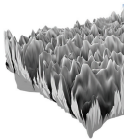
Basic Quartz Stain Removal
If you notice a spot or discoloration that appears to be a stain, follow these steps:
1. Apply Beyond Stone Solutions Easy Oxy:
- Apply the cleaner directly onto the affected area.
- Let the product dwell for a few minutes to allow it to penetrate any residues.
- For tougher stains, use and follow the instructions for Beyond Stone Solutions Easy Scrub.

2. Wipe away:
- After allowing the cleaner to dwell, wipe the area with a clean, soft cloth or sponge.
- Repeat this process if necessary, especially if you see a lightening of the stain, until the stain is removed.
3. Persistent discoloration:
- If the discoloration persists after multiple cleaning attempts, it’s time to call in your service pro.
Beyond Stone Solutions Easy Oxy and Beyond Stone Solutions Easy Scrub can be found at all Arizona Tile stores or at shop.beyondstonesolutions.com.
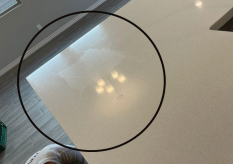
Resin and Solvent Burns
The resins used in manufacturing Quartz can burn when exposed to high heat. Strong solvents can react with these resins, causing discoloration or surface damage that appears stain-like but is more severe.
Resin and solvent burns are types of surface damage that require
professional restoration to correct. If your Quartz surfaces are affected, contact your Stone Restoration PRO for expert assistance.
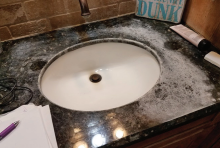
Mineral Deposits
These can form when hard water dries on the surface leaving behind a white, chalky residue. Mineral deposits are not stains but rather build-up from dissolved minerals like calcium or magnesium in the water. They can appear as white or cloudy spots and are most common around sinks or areas with frequent water exposure.
1. Beyond Stone Solutions Easy Scrub can remove most mineral deposits.
- Apply a liberal amount of Beyond Stone Solutions Easy Scrub to the surface and scrub by hand or with a low RPM machine using a soft white pad, non-abrasive scouring pad, or the appropriate Melamine pad.
2. Rinse any remaining residue with Beyond Stone Solutions Easy Oxy and buff dry with a microfiber towel.
3. Repeat as needed:
- For stubborn deposits, you may need to repeat this process several times.
Beyond Stone Solutions Easy Scrub removes mineral deposits from other surfaces as well, as shown in this before-and-after image of mineral deposits on a shower’s glass blocks.
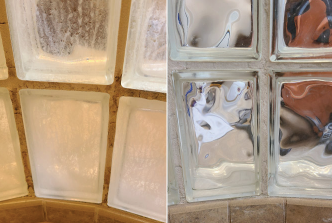
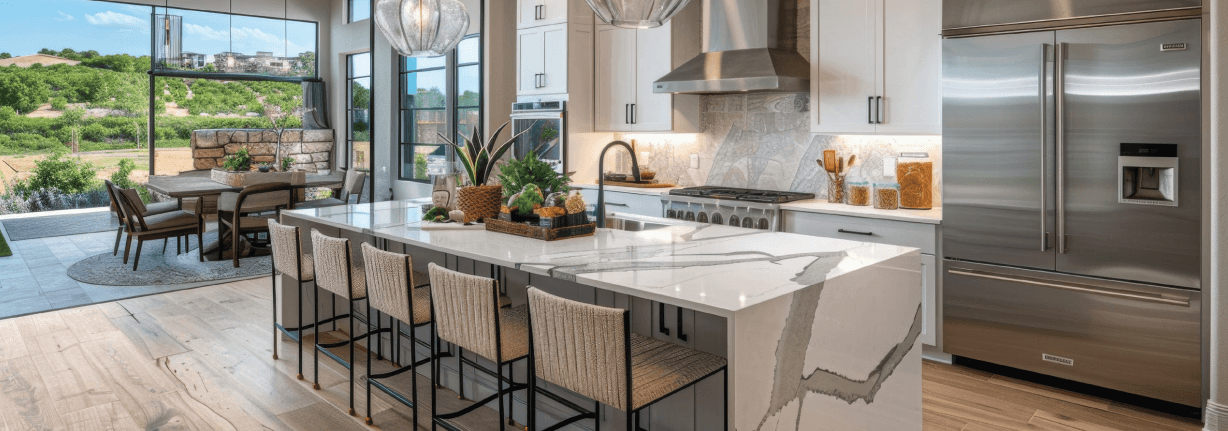
Tips to Prevent Stains and Surface Damage on Quartz
DO: use Beyond Stone Solutions Easy Scrub or Beyond Stone Solutions Easy Oxy quartz stain remover for tackling tough spills and keeping your countertops clean.
DO: wipe up spills immediately to prevent them from settling into the microscopic texture of the quartz surface.
DO: use cutting boards and trivets to protect countertops and other quartz surfaces from scratches, excessive heat, and heavy impacts.
DO: contact Beyond Stone Solutions, or your local stone restoration contractor if you discover any surface damage.
DON’T: use solvents, harsh chemicals, or abrasive cleaners like bleach, oven cleaners, or highly acidic/alkaline solutions. These can damage the resin and dull the surface.
DON’T: use rough scouring pads or steel wool, as these can dull and scratch the surface.
DON’T: place hot pots or pans directly on the countertop. While quartz surfaces are heat-resistant, they aren’t entirely heatproof. Placing a hot pot or pan directly on the surface can lead to thermal shock or discoloration. It’s always recommended to use trivets or hot pads to prevent damage.
Design With Quartz
All of this may make it seem like quartz is a high-maintenance surface but it’s actually one of the easiest to maintain with its more scratch-resistant and durability features. If you want to design with a product that will last and add value to your home or business, quartz is a great choice.
Questions? Need Services or Support?
The information provided in this guide is intended to be helpful and informative. However, it’s important to note that individual circumstances may vary. Always exercise caution, conduct a test in inconspicuous areas, and prioritize safety measures, especially when dealing with chemicals or unfamiliar materials. The users of the information are encouraged to take appropriate safety precautions and seek professional advice if needed.
